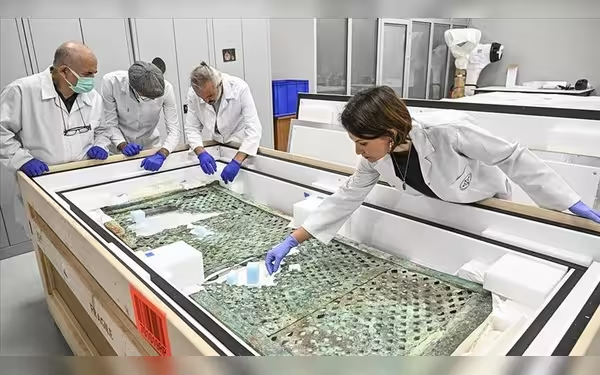Saturday, November 16, 2024 07:33 PM
Bronze Age Artifact Repatriated to Türkiye After 40 Years
- Ancient bronze kline returned to Türkiye after 40 years.
- Artifact linked to grave near Manisa province.
- Total of 36 artifacts repatriated to Türkiye in 2024.
 Image Credits: thefrontierpost
Image Credits: thefrontierpostA rare bronze kline, missing for over 40 years, has been returned to Türkiye, highlighting the importance of cultural heritage preservation.
In a significant cultural development, an ancient artifact that had been missing for over 40 years has finally returned to Türkiye. This artifact, a rare bronze kline, was illicitly excavated from the Aegean region in the early 1980s and subsequently smuggled out of the country. The return of this historical piece was made possible through the dedicated efforts of the Culture and Tourism Ministry of Türkiye, highlighting the importance of preserving cultural heritage.
The bronze kline, which dates back to 530 B.C., is a rectangular couch that was commonly used in ancient Greece and Rome. It was returned to Türkiye by the prestigious J. Paul Getty Museum, where it had been purchased in 1982. Scientific studies have confirmed that this kline was taken from a grave near Manisa province, making its return a significant event for Turkish archaeology.
Upon its arrival, the kline was delivered to the Istanbul Restoration and Conservation Center and Regional Laboratory Directorate. Here, experts carefully opened and examined the artifact. Conservator and restorer Deniz Nurcan described the kline as a unique piece, stating, "This is a bronze piece. It is produced with a copper and bronze mesh over an iron skeleton, with cast bronze feet. In this sense, it is rare; we typically don’t see such examples." This statement emphasizes the rarity of the kline, as most klinas from that era were made from stone and wood.
Interestingly, linen fragments found on the kline matched perfectly with wooden and bronze plates discovered by Turkish archaeologists at the excavation site. Nurcan explained, "It was determined that they date to the same period. Thus, it has been established that the artifact is indeed a part of our cultural heritage." This connection not only reinforces the kline's historical significance but also showcases the collaborative efforts between Turkish archaeologists and experts from the Getty Museum.
The kline itself is a fascinating example of ancient craftsmanship. Constructed on an iron skeleton with cast bronze feet and rails, it features perforated copper plates. Its design includes turned legs, protruding tenons at the corners, and a lattice surface that supported cushions. Such klinas were often depicted in historical paintings and pottery from the Bronze Age, serving as furniture for resting and dining.
With the return of this kline, the total number of artifacts repatriated to Türkiye in 2024 has reached 36. Over the past six years, an impressive 7,840 artifacts have been returned, and since 2002, a total of 12,155 artifacts have been repatriated. This ongoing effort underscores the importance of reclaiming cultural heritage and the commitment of Türkiye to preserve its rich history.
The return of the bronze kline is not just a victory for Türkiye; it serves as a reminder of the importance of protecting cultural artifacts worldwide. Each piece tells a story, connecting us to our past and enriching our understanding of history. As more artifacts are returned, we are reminded of the shared responsibility to safeguard our global heritage for future generations.













